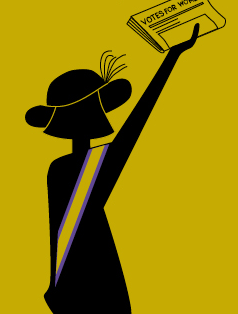
What feels like a long, but really quite short, 95 years ago, women in the United States acquired the right to vote. Following an immeasurable amount of effort put forth by women and men in favor of voting equality, women’s suffrage was scribed into our Constitution on August 26,1920. Critically speaking, voting access was not granted to every citizen simply because women’s suffrage made voting gender-inclusive. Initially the new ruling benefited only upper-class white women. It wasn’t until many years later that poor citizens and women of color broke through systemic obstructions to voting rights, a problem that exists to this day. Furthermore, transgender and gender-non-conforming citizens still battle voting access when not able to change their documented gender or identify with either male or female.
Luckily, however, women’s suffrage set a precedent of inclusion for minority populations in our country. By extending the right to vote to a previously-silenced group of citizens, our nation’s leaders commissioned a new message that all people deserve a say in making decisions about who runs government matters. Given that different populations have different needs, the women’s suffrage ruling consequently provided women with the opportunity to address issues that pertain to them specifically via participation in elections.
One issue in particular, of great importance to women and families, is that of reproductive justice. Prior to 1965 it was illegal for married couples to use the birth control pill invented by Margaret Sanger. It wasn’t until 1972 that unmarried couples could use the family planning tool as well. The following year abortion was legalized by way ofRoe v. Wade.If it weren’t for the collective voices of men and women to pass these new laws, via suffrage for all, they would most likely not exist. In this case the extension of suffrage to women citizens effectively equipped them with a tool with which to compound equality into more equality.
One of the clearest measurements of gender inequality is that of the gender wage gap. Due to the fundamental difference between men and women, that the majority of female bodies can get pregnant while the majority of male bodies cannot, if one decides to start a family, it will most likely be the woman who leaves the workforce during pregnancy. Thanks to recent laws like Rhode Island’s Temporary Caregiver’s Insurance, men and women can securely leave any type of work during these times. Regardless, it is the frequency of women leaving the workforce to start families which causes them to lose capital and climb the economic ladder behind their male counterparts. Although nowadays women follow career paths at the same pace as men, the gap of time off work they more often take creates the substantial gap in income over time.
While on the one hand there are still few options for families to have unconditional paid family leave, in addition to the trend of more women exiting the workforce to care for children, the base level economic security for both men and women is that they have access to family planning tools in the first place. Were abortion and contraception services never available due to voting restrictions for women, they would have had an even harder time rising to the same level of autonomy as men. Not being able to choose when one is pregnant or not pregnant means a higher rate of unplanned pregnancies and a higher rate of women struggling to maintain economic security.
As we head into our next election, it is important to be mindful of the platforms of our 2016 candidates in regards to reproductive rights. Women have the right to vote so that we can participate in electing government officials who will help us make the best decisions possible for our overall well-being.Without access to reproductive services, women are more vulnerable to being pregnant than they are equipped with resources to family planning and maintaining their autonomy.

